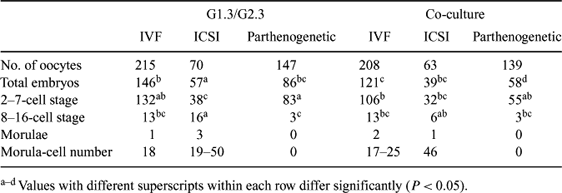283 DEVELOPMENT OF CAPRINE EMBRYOS PRODUCED BY ICSI AND IVF AND CULTURED IN DIFFERENT MEDIA
A.R. Jimenez-Macedo A , B. Anguita A , D. Izquierdo A and M.T. Paramio AAFacultat de Veterinaria, Universitat Autonoma de Barcelona, 08193 Bellaterra, Barcelona, Spain. Email: teresa.paramio@uab.es
Reproduction, Fertility and Development 17(2) 291-292 https://doi.org/10.1071/RDv17n2Ab283
Submitted: 1 August 2004 Accepted: 1 October 2004 Published: 1 January 2005
Abstract
Embryo development of IVM-IVF prepubertal goat oocytes is low. The ICSI techniques may allow fertilization of all IVM oocytes. The objective of this study was to assess the efficacy of ICSI compared with IVF, for embryonc development of prepubertal goat oocytes. Prepubertal (1- to 2-month old) goat oocyte were recovered from a local slaughterhouse and matured in a conventional IVM medium (TCM199 with serum, hormones and cysteamine) for 27 h. Spermatozoa from fresh ejaculates were selected by swim-up and capacitated with heparin. IVM oocytes were divided into three groups: (1) oocytes fertilized using conventional IVF methodology, (2) ICSI oocytes activated by sequential treatment with 5 mM ionomycin for 5 min and 2 mM 6-DMAP for 4 h; and (3) parthenogenetic oocyte group used as a control for chemical activation. Presumptive zygotes and activated oocytes were cultured in TALP fertilization medium for 24 h. After fertilization, all groups were divided into two groups and cultured for 192 h in: (a) sequential media G1.3/G2.3; or b) TCM199 with granulosa cells. The number of cell nuclei in embryos was assessed by Hoescht staining. Each experiment was repeated seven times, and results were analyzed using chi-square or Fisher's test. The percentage of total embryos obtained after IVF, ICSI, and chemical activation was higher (P < 0.05) for ICSI than for IVF in G1.3/G2.3 (81.4 and 67.9%, respectively) but not in co-culture (61.9 and 58.2%, respectively). The percentage of total embryos was higher (P < 0.05) in G1.3/G2.3 than in co-culture for both IVF oocytes (67.9 and 58.2%, respectively) and ICSI oocytes (81.4 and 61.9%, respectively). The highest percentage of 8- to 16-cell embryos (28.1%) was obtained in the ICSI group cultured in G1.3/G2.3 medium. We did not find significant differences among the experimental groups in the percentage of morulae. In conclusion, ICSI improved the percentage of embryos developing beyond the 8-cell stage. However, this difference could be due to the additional effect of the chemical activation. Embryo development was also improved by using G1.3/G2.3 embryo culture medium rather than TCM-199 with granulosa cells. The ICSI procedure could be a useful tool to study more accurately the oocyte competence for embryo development.

|
This study was supported by MCYT (Spain), Grant AGL 2000-0353.


